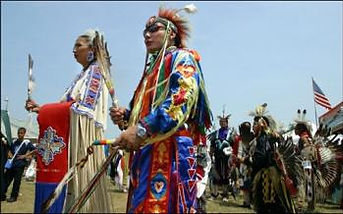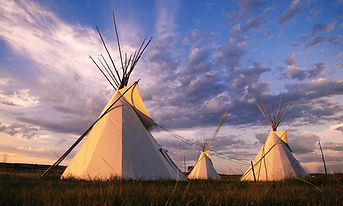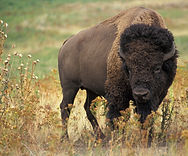
Native American Literature Anthology 2.0
Sara Downs
Luther Standing Bear
Luther Standing Bear was born in the 1860's into the Lakota tribe of the Teton Sioux. He obtained the name Luther after being enrolled in the Indian Boarding Schools when he was a boy. Throughout his life he held many jobs such as a store owner, assistant minister, teacher, and member of Buffalo Bill's Wild West Show. He even appeared in several movies. Over the course of his life he published four books in which he wrote eyewitness accounts of Lakota ceremonies and traditions. He was active until the time of his death in 1939.

1



The Sun Dance
The pole was always a cottonwood tree...No other tree would do. It was not a straight, but there was always a branch which extended out from the main trunk. This would be about thirty or forty feet up. This branch would be cut off about four feet from the trunk. On the top of the pole, branches with leaves on would be left...it looked not unlike a huge cross, when viewed from a distance.
Many things were done during this dance which were similar to what I have read about Christ. We had one living sacrifice, and he fasted three or four days instead of forty. This religious ceremony was not always held in the same place. We did not commercialize our belief. Our medicine men recieved no salary. Hell was unknown to us. We trusted one another, and our word was as good as the white man's gold of to-day. We were then true Christians.
At Last I Kill a Buffalo
I went to bed, but could not go to sleep at once, so filled was I with the wonderment and excitement of it all. The next day was to be a test for me. I was to prove to my father wheter he was or was not justified in his pride in me. What would be the result of my training?...It was a test of my real characer and I am proud ot say that I did not find myself weak, but made a decision that has been all these years a gratification to me.
I was soon by the side of the buffalo and one more shot brough the chase to a close. I jumped from my pony, and as I stood by my fallen game, I looked all around wishing that the world could see...Everyone must know that I, Ota K'te, had killed a buffalo...That ended my first and last buffalo hunt. It lives only in my memory, for the days of the buffalo are over.
Luther Standing Bear is known for his eye-witness account of traditional Sioux practices. "The Sun Dance" is no exception. In this short story he tells the reader what a traditional Sun Dance entails. The first paragraph describes the tree in which the tribe used for the anchor of the sacrafice. The fact that Standing Bear compares it to a cross is profound. Despite all the traditional practices he witnessed, he chose to compare the tree to a cross. In the second paragraph Standing Bear again compares the Sun Dance to Christianity. Both practices have sacarfice. Jesus was sacrificed on the cross after fasting forty days, where as the tribe member was sacrificed after fasting for three or four. Both men were beaten and tortured and both involved a wooden "cross". In a way it was like the tribe were the better Christians. They're practices were pure and the word was law. It was by Christ's name that the white men controlled and abused the Indians. Priests and Pastors are paid and make a decent living, while it was birthright to be a medicine man.
It was difficult for me to find a select few passages from this short story. Luther Standing Bear was one of my favorite authors of the semester and I would re-type the entire selection if I could. These two paragraphs interested me the most because of the comparisons to Christianity. In the poem "Hawk Nailed to a Barn Door" I talked about the influence of religion on the native people and here it is again. Not only that, but I believe Standing Bear has a strong argument when he says they were true Christians before they even converted. They followed God's law in the purest form without even knowing it. It took conversion to corrupt their pure spirituality.
This is another prime example of Luther Standing Bear's preservation of the Sioux culture. Here he tells his first-hand account of the rite of passage for a young Sioux boy: the first buffalo hunt. In the first selected paragraph Standing Bear shows the reader just how important the buffalo hunt is to a young boy. Growing up, it was a boys job to learn out to hunt so that one day he could provide for his family. This also reflected back onto his father and how well he trained his son. This was a boy's first test. The second selection was the paragraph in which Standing Bear finally kills his buffalo. It took him five arrows, but eventually he won. A Sioux boy's finest moment was killing his first buffalo. As stated in the exerpt, he wanted the whole world to know. He was filled with pride. However, as a Sioux he couldn't outwardly show his pride. Instead he had to maintain a calm demeanor despite his inward jubilation. The last two sentences of the second paragraph are the the last two sentences of the short story. The most obvious interpretation would be that it wasn't long after Standing Bear's first buffalo hunt that the white man came and put an end to all of their practices. The day of the buffalo ended when the white man went through and almost drove the species to extinction. However, it could also be interpreted as that was the last buffalo hunt that really mattered to Standing Bear. The first one was done, and so began the rest of his life following and hunting the buffalo.
This was one of my favorite readings from the semester. It's known that the plains Indians mains source of survival were the buffalo, but this story illustrates a deeper meaning to it. Not only were the buffalo a way of life, the first hunt was a rite of passage. I always enjoy the way Standing Bear rights, but during the chase I felt like I was in the action and I read faster and faster, trying to see if he would get his buffalo and make his family proud. The last two lines of the story were some of the best in the story. It really concluded the entire short story well. He did a really god job in eluding to the fact that the white man took away a sacred practice. Not only did they kill almost all of the buffalo, they forced the kids into school and forbade them to practice traditional practices. I finally realized just what the white man did when he took away the natives way of life.
